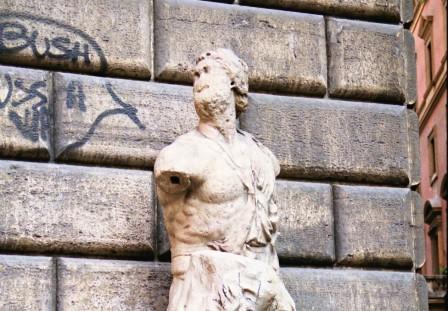fg
It is believed that the original 'Pasquino' was a tailor living on the Campus Martius who was rather outspoken in his political views. It therefore seems most appropriate to start with the statue that commemorates him!
PASQUINO
As well as being 'the original', most of the best barbed comments and most memorable quotes are associated with Pasquino (the statue) himself. It stands at one angle of a triangular piazza bearing his name, just south-west of Piazza Navona.
To reach it, head first for this square, and stand in front of Bernini's 'Fountain of the Four Rivers', facing down the piazza with the church of S Agnese in Agone behind you on your right (for more on the square & the fountain, see 'The Obelisk Trail'). Aim for the right-hand corner ahead of you, and then walk along the road leading out of the square at this point (it is helpfully called Via di Pasquino...) As the road opens out into a piazza, the statue stands just to your left.
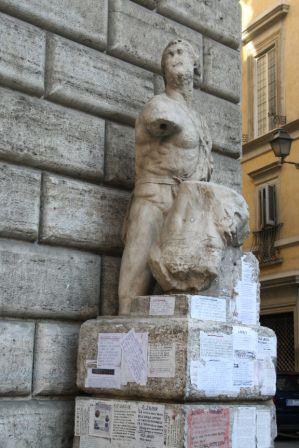
You may or may not find yourself agreeing with Bernini that this misshapen fragment is the finest Classical work you have seen…in its twisted shape there is something quite uncomfortable, almost 'Bacon-esque' about it. This may be partly the result of its supposed subject: it is believed to have been the remains of a statue (probably part of a tableau) of the Greek hero Menelaus cradling the body of Achilles' favourite Patroclus just after he has been killed in battle by Hector the Trojan prince. Certainly the sense of anguish is palpable. It may well originally have stood in the nearby Stadium of Domitian (now Piazza Navona, and from where this square gets its characteristic shape). The tradition is that after it had been set up in its present position in 1501, in memory of the outspoken tailor Pasquino, people began to hang placards around its neck protesting about the policies and practices of the city's rulers, and the statue became known by his name.
The original "Pasquinades" by the tailor have been forgotten - he is supposed to have had customers in the Vatican, and so picked up plenty of gossip by that route! Some of the more famous surviving quips however include the brilliantly apt complaint made when the Barberini Pope Urban VIII stripped the Pantheon portico of its bronze ceiling (to be melted down to make the baldacchino in St Peter's and 80 cannon for Castel Sant'Angelo) - a sacrilege attempted not even by the invading waves of Goths and Vandals:
"Quod non fecerunt barbari, fecerunt Barberini" - "What the barbarians didn't do, the Barberini did!"
Another good one was the hanging of a tin collecting-cup on the statue with the pleading message "Alms for the completion of the Farnese Palace" when the fabulously wealthy Farnese family found their finances under a bit of a strain (see also 'A Ride on Bus 116'); and there were also some memorably unflattering observations about Queen Christina of Sweden, the larger-than-life eccentric who had left her own land and taken up residence in Rome: "A Queen with no country, a high-priestess with no religion, a woman with no shame…". Pope Hadrian VI, quite early in Pasquino's career, once proposed that the statue should be pulled down and thrown in the Tiber; but one of his more perceptive advisers warned him that this might only infect the river-frogs to croak Pasquinades even more loudly..!
In recent years it has been a common sight to find the statue completely plastered in sheets of paper containing (admittedly not-very-epigrammatic) anti-government diatribes. I hope you will find something amusing - and legible...
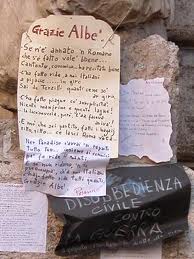
From the Piazza di Pasquino, head left from where you entered the square along Via di San Pantaleo; you will shortly find yourself in the Piazza of the same name, on the edge of the traffic-ridden Corso Vittorio Emanuele II. Here you need to cross - fortunately the traffic is controlled by lights to assist the never-ending stream of people traipsing between Piazza Navona and the Campo de' Fiori. You could reach your next destination rather more quickly by walking along the main road; but it is much more rewarding to make a short detour over the site of one of Rome's hidden surprises - the Portico and Theatre of Pompey the Great.
Continue, then, straight ahead up Via dei Baullari, and take the first turning to your left (if you find yourself in the Campo, you've gone too far!) This brings you into the Piazza del Teatro di Pompeo. Bear to the right as the piazza broadens beside a restaurant: it now becomes, briefly, Piazza Pollarola. Ahead you will see, leading off to the left, the Piazza di Paradiso (possibly not the most appropriately named square in the city…),and almost directly ahead, the Albergo Sole.
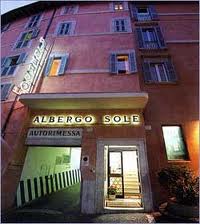
This hotel is reputedly 'the oldest in the city'; in its cellars you can see remains of the foundations of the Theatre of Pompey, so there is certainly likely to have been a building of some sort there for a very long time. The quirky Ristorante to its left ('Le Grotte del Teatro di Pompeo') seems to have closed down; from my own experience this place wasn't horrendous (and the food was actually not at all bad),but judging from reviews from others concerning its service and 'erratic' charging, this is probably not altogether surprising...
Continuing on past the Albergo Sole in the direction of the Campo you soon reach Piazza del Biscione (all these 'Piazzas' are little more than a broadening of the road at junctions). Here you will find a restaurant that can be recommended unreservedly: the Ristorante 'Da Pancrazio' has had a very good reputation for many years. Once again (if you ask nicely) you may be able to see more remains of Pompey's theatre in the cellars.
THE THEATRE OF POMPEY
In Republican times - roughly the 500 years before Julius Caesar upset Rome's government for ever in the middle of the first century BC - it was illegal to construct a permanent theatre in the city. Acting performances hitherto had made do with D-I-Y stages built ad hoc by travelling troupes of actors touring around the country. Unlike the Greeks, who elevated drama into high art, the Romans could never quite bring themselves to consider 'acting' a respectable profession. Rather than the intricately crafted tragedies of Sophocles and Euripides or the varied (and surprisingly modern) political comedies of writers such as Aristophanes, the Romans preferred much more down-to-earth mimes and farces full of gross buffoonery - or, to be honest, the more grisly and exciting entertainments of the Circus and Amphitheatre. By the first century BC however, thanks largely to the success of comedy writers such as Plautus, more 'structured' acting performances were becoming popular with the masses, and in 61BC Pompey the Great (Caesar's political rival) realised the potential for some extra popularity.
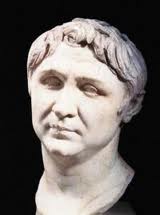
He found a way around the ban on permanent stages in a very clever fashion: his theatre was built nominally as a temple to the goddess Venus (the seats were supposedly 'stairs' leading up to the altar above). That way, 'entertainments' could be put on in the open area below, and there was no cause to call for the structure to be demolished afterwards. It is believed that the large, irregular building on the corner of the Campo and the piazza you are currently in marks the site of this Temple of Venus.
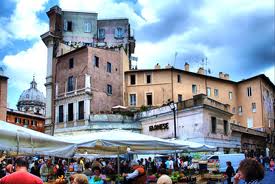
Aiming left, you will find (hopefully unlocked!) a 'hidden' passageway leading out of the piazza - the Passetto del Biscione. Where you enter, behind glass, there are some reproductions of patterns in painted stucco (foliage & candelabras); the originals of these were once to be seen beneath this passage, in the crypt of the now deconsecrated church of S. Maria di Grotta Pinta (it is now some kind of theatre) which is on your right as you emerge at the far end of the passage. This was most likely the 'painted grotto' commemorated in the church's name, and in that of the street you now find yourself in.
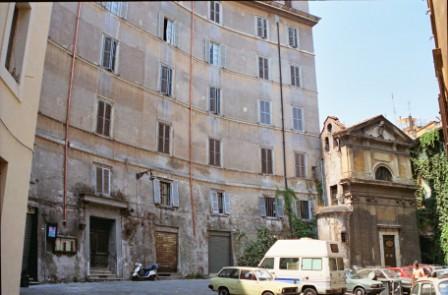
Take a look at the shape of the buildings around you. The unmistakable curve along the Via di Grotta Pinta reflects in an extraordinary way the shape of the seating area of Pompey's Theatre. You are standing in nothing less than the focal point of the whole structure: this piazza would have been the area known as the 'orchestra', where the city magistrates and senators had their seats; the 'lesser classes' had to sit progressively further back. If you walk around to your right, the name of the Piazza here ('…dei Satiri') once again commemorates the actors, who wore grotesque 'satyr'-like masks to emphasise which type of role they were playing.
Continue your anti-clockwise circle, and you will reach Via dei Chiavari, which marks the straight side of the theatre's semi-circle, where the actual stage would have been. At the end of this road you must now briefly rejoin the main Corso Vittorio Emanuele. Turn right, and walk across the front of the church of S Andrea della Valle (for a little more info on this church see 'A Ride on Bus 116'). Around the corner, in Piazza Vidoni, stands our second Talking Statue.
ABATE LUIGI
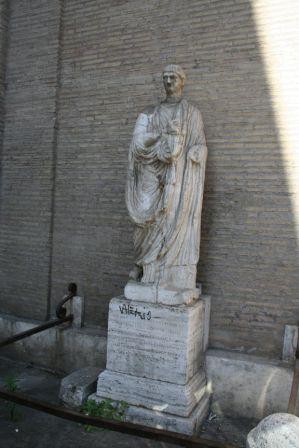
'Abbot Louis' is one of the less well-known of the group. He has stood here in Piazza Vidoni only since 1924; before that he was closer to the nearby Chiesa del Sudario, taking his name (allegedly!) from a sacristan or some other official of that church, whom he was supposed to resemble. It is uncertain whether he would recognise himself now: the head has had to be refitted (if not completely replaced!) several times over the centuries - it seems to have been an irresistible target for some of Rome's rowdier protestors; the most recently attached head has also now been knocked off... His body is an ancient original - some once-famous but now unidentifiable senator, to judge from his natty toga. Despite his irreverent treatment, he has taken his job as spokesman for Rome's disaffected pretty seriously: the inscription on his pedestal translates resolutely enough, befitting his noble origins:
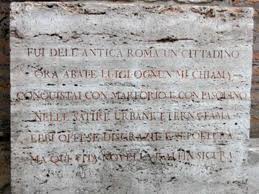
I WAS A CITIZEN OF ANCIENT ROME
NOW EVERYBODY CALLS ME ABBOT LOUIS.
WITH MARFORIO AND PASQUINO I WON
ETERNAL FAME WITH URBAN SATIRE.
I RECEIVED OFFENCES, MISTREATMENT AND BURIAL
BUT A NEW LIFE HERE, SAFE AT LAST
Let's hope that our more responsible generation will allow him to pass his future years unmolested!
From Piazza Vidoni, to avoid the main road once more, you can walk over a little more of the area of the grand portico which joined Pompey's theatre to the earlier temples now uncovered in the square known as the Area Sacra di Largo Argentina.
LARGO ARGENTINA
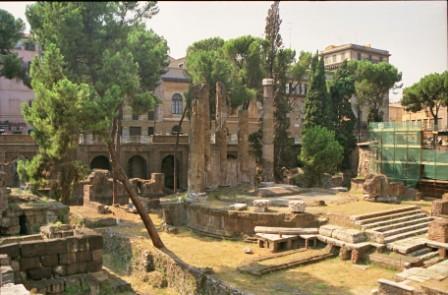
Head left, out of the back of the piazza, and take Via del Sudario. On your right you pass Abate Luigi's church of the SS Sudario, right next to the national church of Belgium, S Giuliano dei Fiamminghi. This will bring you to emerge into this square with a dual personality -part ancient monument, part main transport hub (not to mention cat sanctuary!) As you walk, you are passing over what is generally agreed to have been the exact spot where Julius Caesar met his death in 44BC. As part of Pompey's complex of public buildings, there was here a (temporary) meeting-house for the Senate (the better-known one in the Forum was still under reconstruction after having been burnt to the ground in the riots that followed the murder of the rabble-rouser Publius Clodius Pulcher some years earlier). It was here that Caesar's assassins attacked him on the Ides of March: ironically, he is said to have fallen at the feet of a statue of Pompey himself (also dead by now in the civil wars that took place between Caesar the iconoclast and the Senatorial patricians with Pompey as their main general). It is possibly the very statue that stands in the nearby Palazzo Spada and can now be viewed alongside the rest of the interesting collection there…or possibly not.
When you emerge into Largo Argentina (named after the former opera house, where classics such as Rossini's 'Barber of Seville' received their premiere - nowadays it is home to the main Theatre of Rome company),cross over the tram-line (number 8 to Trastevere),head over a little to the right, and look down into the sunken square. You will do well to identify much from the ruins, but there are actually at least 4 separate small temples there, including a round one - temples of this shape are usually very early.
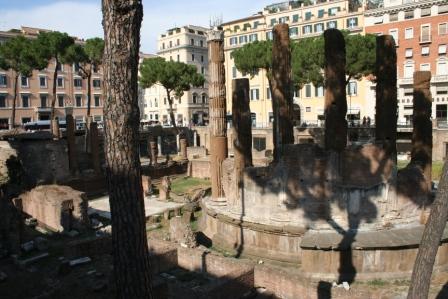
Behind them, just below where you are standing, you may just make out the steps leading to the Senate's meeting-house, and a little further up to the left, the remains of a public loo ('forica'). Ancient Rome was rather better equipped with such facilities than it is nowadays!
The stairway that goes down at the right corner nearest you leads to the headquarters of Rome's cat-rescue sanctuary: there will inevitably be a few of its residents staring languidly up at you.
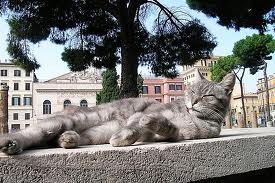
TOWARDS THE CAPITOLINE HILL
At this point, it is probably time to think about taking some transport to reach the area where our next two statues can be found. Truth to tell, it's not a long walk, and there are one or two points of interest along the way (in particular the 'Crypta Balbi', one of the four sites of Rome's main city museums): but they are not the main reason for this particular itinerary!
So, continue to the far right corner of the sunken square as you approached it, and make your way a short distance down Via Arenula. Here you can find the 'stop' for Rome's most pleasant form of public transport - no traffic jams, no queues, no manic rival drivers - the wonderful Tram 8, which since 2013 has been running from across the river right into the city-centre at Piazza Venezia. It brings you back past Largo Argentina along Via Florida, which becomes Via delle Botteghe Oscure ("Street of the Dark Shops" - there aren't actually many shops any more, but it's still pretty dingy!)
The tram heads along the Street of the Dark Shops. There is one only one stop to go, as it soon arrives into the extended spread of Piazza Venezia. This is its actual terminus, beside the church of San Marco; across the square opposite are the stairways that lead up to the top of the Capitoline Hill - 'Campidoglio' to the modern Romans.
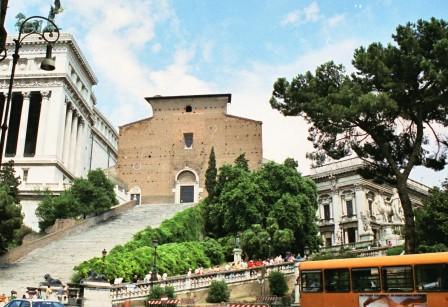
The steep staircase on the left takes you to the unusually bare and unfinished façade of the Church of S Maria in Aracoeli, which stands close to the site of the Temple of Juno Moneta on the northern summit of this hill of twin peaks. The more gentle incline to the right is Michelangelo's famous 'Cordonata'.
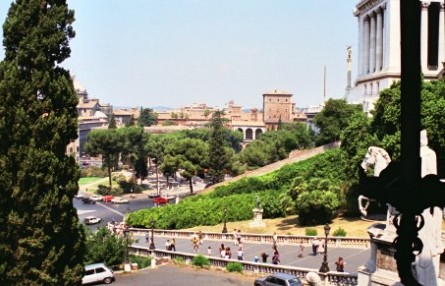
Make your way around the right hand side of the Piazza, then take a deep breath, stare straight ahead and stride out boldly across the murderous Via del Teatro di Marcello (using a crossing will give you a slightly better chance of making it alive). At the bottom of the stairway stand a fine pair of lions from one of the Egyptian cult temples. As you walk up the Cordonata, look to your left to see the dark statue of Cola di Rienzo, twice the favourite of the fickle affections of Rome's citizenship, desperate for a leader to restore the city's ancient fortunes after years of riots and murders between the warring grand families.
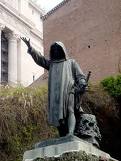
Sadly, falling victim to what can only have been megalomania, he eventually went too far (taking a bath in the green porphyry Baptistery basin at St John Lateran before appearing dressed in scarlet, announcing himself 'Elect of the Holy Spirit, the Cavaliere Nicola, the Friend of the World, Tribune Augustus' might have been one giveaway that all was not well…),and in the end he was chased down and killed at this very spot in 1354.
Guarding the balustrade at the top are statues of the Twins, Castor and Pollux the 'Dioscuri', long believed to be Rome's special divine protectors.
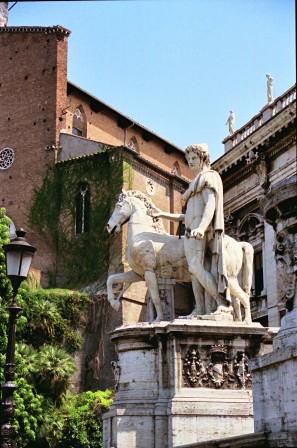
Standing in Michelangelo's beautiful star-pointed square is the horse-borne figure of the emperor Marcus Aurelius (or a copy at least of the famous statue, which still bears traces of the gilding which must never flake off entirely or Rome will fall). This statue, which stood for many years outside the Lateran Basilica, only survived Christian persecution because it was believed to represent Constantine the Great, who legalised the faith.
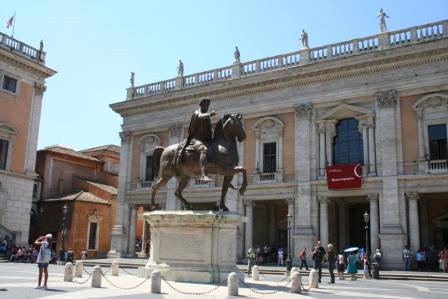
At the back of the piazza, on the front of the Palazzo Senatorio - Rome's 'Town Hall' - two reclining figures representing river-gods (the Nile and the Tiber) recline either side of the twin staircase, and in the middle stands the Goddess Roma herself (once an ancient statue of Minerva).
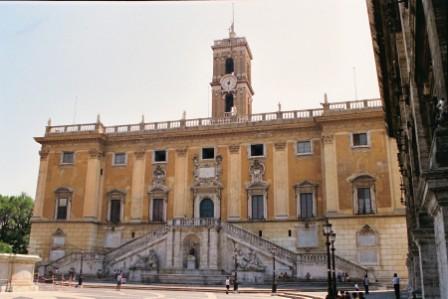
None of these statues, however, can talk. To see our next participant in the conversations, you must look somewhere more concealed.
The two palaces which face each other across the piazza house the wonderful Capitoline Museums. Entrance to these is in Palazzo dei Conservatori on your right, and the exhibition continues into Palazzo Nuovo on your left, passing underground through part of the ancient Tabularium, or public records office, which overlooks the Forum beneath the middle building, Palazzo Senatorio. You should certainly visit this great collection at some stage: at the end of the visit, you will emerge into the courtyard of the Palazzo Nuovo, where now reclines Marforio - and you can get a decent enough view of him now by looking through the 'exit' of the museum on your left.
MARFORIO
He is a giant figure, probably of a River-god. His name is generally thought to reflect where he was originally found, in the 'Mars Forum' - the Imperial Forum built by Augustus, the focal point of which was a great Temple of Mars built by the first of the Emperors in thanks for his eventual victory in the series of civil wars that followed Caesar's assassination. Another explanation is that his name is a contraction of 'Mare in foro' - 'the sea in the forum', based on his identification as a water-god. We will never know for sure.
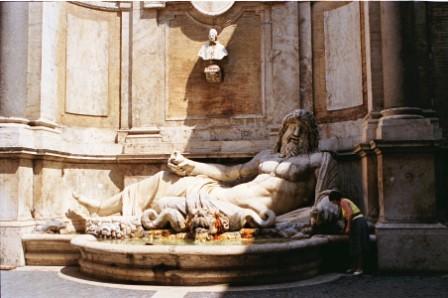
Probably the second most famous of the six, he used to carry on 'conversations' with Pasquino on topics of current interest or scandal. One famous example was set in the time of Pope Clement XI, who seemed to be spending more time in his home city of Urbino than was thought proper: Marforio asked "What are you up to, Pasquino?" and received the reply "I'm watching over our city, to make sure it doesn't get moved to Urbino!" Another one took place when Sixtus V 's sister Camilla started putting on airs after her brother's election (the family was of humble origins): "Hey, Pasquino, why is your shirt so dirty? You're looking like a coal-merchant!" Pasquino replied "What can I do? My washerwoman has turned into a Princess!"
It was to try to put an end to these disrespectful exchanges that Marforio was transferred from the spot at the bottom of the hill, to where he had been moved earlier, and put under guard in this way in the Palazzo in 1596. Sadly, it seems to have worked.
Before heading back down the hill, a good place for some refreshment is the café that serves the Capitoline Museums. This is open to all comers, whether or not they have bought a ticket for the displays. To reach it, go around the right side of the Palazzo dei Conservatori, and climb the stairs that lead up from the doorway at no. 4 to the left under the arch. It affords fantastic views over the local district, especially the Theatre of Marcellus.
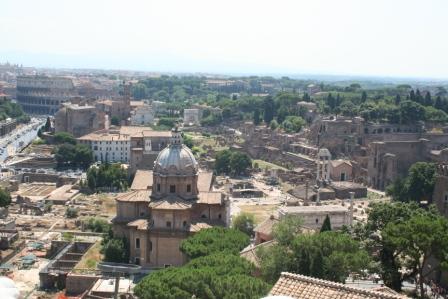
While you are enjoying a well-earned drink here, think back to the earliest days of Rome, when the twin peaks of the Capitoline Hill were crowned with temples to the King and Queen of the Gods. The podium of the Temple of Jupiter practically where we are - all that remains, apart from a few displaced stones in the garden behind - can be seen in the Palazzo dei Conservatori. This café looks down over the edge of the hill that was nearly scaled by invading Gauls in the 4th century BC; the guards - and guard-dogs - slept through the alarm, and it was only the honking of Juno's sacred geese in her temple-enclosure (now S Maria in Aracoeli) that saved Rome from capture on that day. In thanks, Juno was given the honorary title 'Moneta' - 'the Warner'; and when this temple in due course became the depository of Rome's treasury, our word 'money' received its derivation.
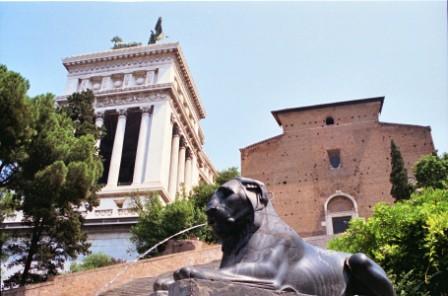
To get back to the stairways, it is easiest to go back down the Cordonata. Before leaving the hill, you can sometimes walk across the front of the V Emanuele monument; certainly you can go round behind, past the panoramic lift to the very top that gives even more spectacular views; or you could first visit the church itself, a grand interior lit by chandeliers. Once at the bottom, spare a moment to look at the jumbled set of red-brick ruins to your right: they are the remains of an ancient Roman 'insula' - a block of flats fronted by shops. Then, steel yourself for another brave march across the roads to the far side of the Piazza, towards the façade of the Venetian basilica of San Marco. You will see a fountain in the shape of a pine-cone: this region (or 'rione') of the city goes by its name of 'Pigna', as you may notice from wall-plaques.
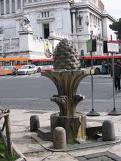
Then, in the back left corner of the garden area in front of the church stands Marforio's other correspondent, our fourth statue: you can scarcely miss the buxom form of Madama Lucrezia!
MADAMA LUCREZIA
Despite only surviving from the waist upwards, this statue is substantial enough…! She was originally, so it is believed, meant to be either the goddess Isis - a temple to her once stood a little further north in the Campus Martius near the Pantheon; or she could have been a statue of the emperor Antoninus's wife Faustina. Her traditional name also has two possible origins: the more amusing one attributes her title to her resemblance to a certain well-endowed lady living in the neighbourhood nearby famous for her 'hospitality'; the other more prosaic explanation (and sadly more likely to be correct) is that she was named after Lucrezia d'Alagno, the mistress of the king of Naples, who moved to Rome when he died, and that she simply owned the statue.
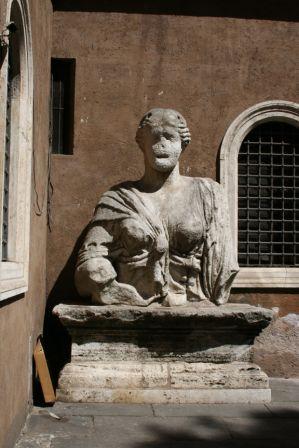
When Marforio was occupying his previous position across the road, the two were well-placed to hold conversations; but we do not have any surviving examples, and with Marforio's incarceration in the Capitoline Museum they are unlikely to be able to correspond again anytime soon.
From the statue of Lucrezia, continue right, in the direction of Piazza Venezia. S Marco (if it is open) may be worth a brief look, especially to admire its broad interior; the best of its treasures is a ninth century mosaic showing an early version of the church itself. Then make your way around the side of the Palazzo Venezia, the main component of this large block. It contains interesting state rooms, used by Mussolini, and a substantial museum of the decorative arts; exhibitions are often held here.
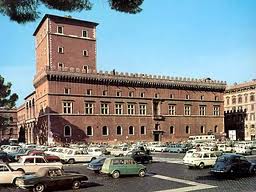
Our current itinerary however continues across the main road (which you have already met in its incarnation as Corso V Emanuele earlier on) - here it is known as Via del Plebiscito. Fortunately the traffic allowed to use it here is limited and you should find it relatively easy to negotiate your way to the opposite side.
A short way along on the right as you head away from Piazza Venezia begins Via della Gatta. Turn up this street: it is not in itself a particularly interesting road, but you are passing, on the right, one side of the magnificent Palazzo Doria Pamphilj, certainly worth a visit on another occasion (for more brief info on this area see 'A Ride on Bus 116') Half-way along on the left it meets with Piazza Grazioli, and the Palazzo of the same name here is the private residence in Rome of a certain Signor Berlusconi (it must have been pretty convenient for his erstwhile official one in Piazza Colonna). Standing on a ledge on one corner of this palace is the creature for whom Via della Gatta is named - again originally probably associated with the Egyptian Isis cult-temple. No-one to my knowledge has ever heard it purr, however, so it doesn't qualify as one of our targets today!
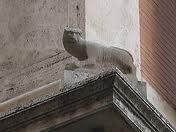
At the end of the road, as it widens into Piazza del Collegio Romano, make your way around the right side of the piazza and take the narrow road leading towards Via del Corso (far right). This road perversely bears the name 'Via Lata' -'Broad Street': not in irony, but rather to commemorate the original name of this end of the Corso in ancient times, when it was indeed an unusually wide stretch (the beginning of the renowned Flaminian Way, leading out of the city to the north). Halfway along Via Lata on the left is statue number five.
Il FACCHINO
This small stone fountain, in the shape of a portly water-seller carrying his barrel - which seems to have sprung a leak! - is known as 'Il Facchino', 'the Porter'. He is the only one of our six who can possibly be identified with a real person: supposedly he represents a gentleman by the name of Abbondio Rizio, delicately described in some stories as 'a heavy drinker'; be that as it may, the statue definitely depicts one of the medieval & renaissance merchants who used to collect water from either still-working aqueducts, or (unpleasant thought) from the Tiber itself and sell it around the streets.
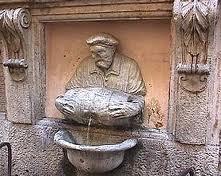
The features of the statue are becoming more and more worn away; at one time, probably based on the characteristic beret that he wears, he was thought to be a caricature of Martin Luther. Unlikely as it might seem, one legend has it that it was carved (at least in part) by Michelangelo: you can make up your own mind on that! Unfortunately again, no actual quotations from him survive today.
Carry on to the end of Via Lata, and you will emerge at the busier end of Via del (or just 'Il..') Corso. To your right stands the very old church of S Maria in Via Lata; fascinating remains of a large ancient storehouse, converted into a Christian meeting place, have recently been open to view beneath it. Here too once stood an arch across the road in honour of the fourth century emperor Diocletian, one of the more savage persecutors of the Christian faith.
Choose your moment to cross the Corso. For future reference, the road opposite you (Via dei Santi Apostoli) is home to one of Rome's rare attractions designed for children: the 'Time Elevator'. This is a sort of interactive film-show on various topics, including one on Rome down the ages, but there's more to it than that suggests: rows of seats that tilt and move, unexpected 'live' special effects. This gets very little publicity - it doesn't even advertise itself very well - but it's worth a visit (with or without children…!) Sadly since the pandemic it seems to be closed - let's hope it reopens eventually.

Further in the same direction, not far from the end of this street can be found two restaurants offering, rather unusually, 'regional' cuisine (as well of course as all the usuals). Just right, on the corner of Via del Vaccaro is 'Abruzzi' - a good, family-run place; or, two turns to the left will bring you to a Sardinian restaurant called 'Il Miraggio', which used to be run by a very hospitable (and entertaining!) family of brothers of 'mature years' from the island. On my most recent visits they seem to have been leaving the service to a younger set of waiters, however, and the atmosphere has suffered a bit; even so, it is worth trying for the Sardinian specialities, especially their home-made 'Mirto' digestif , distilled from myrtle berries.
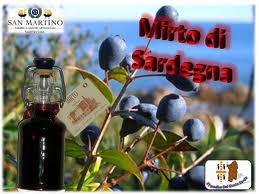
Anyway, at this stage, in order to reach our final statue, a bus-ride is highly recommended; there is one that will take you right to his 'door'! Not far along the Corso you will easily spot a row of bus-stops. The one you want (and it has to be this one) is number 119, recently restored to service. Unless traffic is particularly solid, you shouldn't have to wait longer than about 15 to 20 minutes - probably less; but if things are looking slow, you could just pop into the often rather unfairly neglected church of S Marcello set back from the road almost opposite Via Lata. What you see inside mostly dates from the sixteenth century or later, but there was a much earlier medieval foundation here destroyed by fire, which is under excavation. This is another church which has stood on its spot for some 800 years.
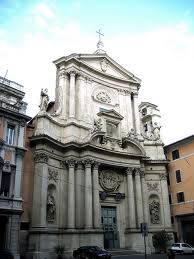
BUS 119
Hopefully you won't have missed a 119 in the meantime…! This bus does a circular journey, starting and ending in Piazza Venezia. Its new route travels either side of the Corso, with visits to Augustus's Mausoleum and the top of the Spanish Steps - the latter of which will help us to reach our next target. To get there you can pick it up here along the Corso where you are waiting.
When it reaches Piazza Colonna it turns right into Via del Tritone (for more info again on this area see 'A Ride on Bus 116'),but soon cuts across, turning left onto Via Francesco Crispi, before finishing its climb up Via Sistina (actually part of one of Pope Sixtus V's long straight roads which cut across town, punctuated by obelisks (see 'The Obelisk Trail'). Here it passes outside the beautiful church of the Trinita dei Monti (see below) at the top of the famous Spanish Steps, and then stops briefly outside the Villa Medici before heading down a hairpin turn to return to the bottom of the Steps, in Piazza di Spagna.
PIAZZA di SPAGNA
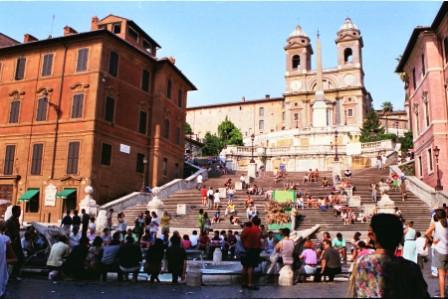
The Piazza has many point of interest to explore on another day - the least of which, perhaps is the presence of a (pretty well-disguised) outlet of a certain American hamburger chain which will remain nameless (it was in fact the first branch opened in the city - imagine the scandal at the time!); the building beside the right-hand side of the wonderful Scalinata (looking from below, as shown in the photo) is home to the Keats-Shelley Museum, being the apartment where Keats was living when he died. The building on the left houses Babington's Tea Rooms, which I am not able to recommend, since I confess to never having taken tea there, put off I'm afraid by the exorbitant prices. Between them rises the famous staircase, whose name of 'Spanish' is rather a misnomer, given that they were built by an Italian and paid for by the French: the name was appropriated from that of the whole square, which in turn was named for the Palazzo di Spagna at the southern end, then the Spanish embassy to the Vatican. To complicate matters further, the whole area was known as the 'English Ghetto', being a favourite lodging district for Brits ever since the days of the Milords on their Grand Tours. Above all stands the church of the Trinita dei Monti with its accompanying obelisk (see 'The Obelisk Trail').
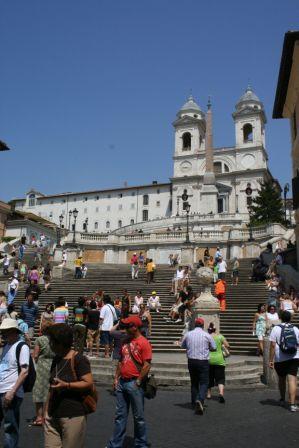
The whole wonderful setting is the subject of countless paintings and photographs, several dozen new ones doubtless being taken as the bus continues on its way.
At the foot of the stairs, completing the un-improvable scene, is the fountain of the 'Rotten Old Boat', the 'Barcaccia', now believed to be another of Bernini's masterpieces (it was once thought to have been the work of his father). It commemorates an old barge which was washed up onto the slopes of the Pincio Hill nearby during one of the devastating floods Rome suffered periodically before the Tiber was encased in its current massive embankments. The jets of water (a great boon to the North African rose-sellers - the ones that aren't peddling whirly LED flying helicopter wheels - to help them to revive their drooping blooms) achieve their strong flow from the extra pressure created by its sunken position below ground level. The water itself comes from the ancient 'Aqua Virgo' aqueduct - reckoned to be the purest in Rome. You need have no qualms about stooping to have a drink here yourself: I keep a bottle with me constantly refilled from this fountain on my own travels across the city!
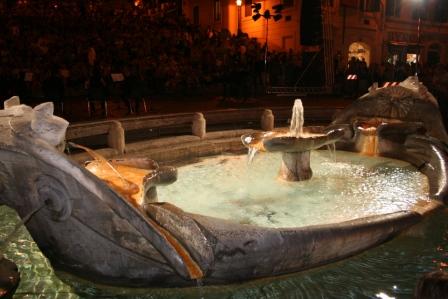
Opposite the fountain, beside the ever-present hot-chestnut man (even during the height of summer!),descends the Via Condotti. This is not just known for its classy designer shops, but also for the long-established Caffe Greco - still giving a genuinely pleasant welcome to its modern visitors, just as it has done to far more famous names, and serving good coffee at prices no more expensive than most road-side bars.
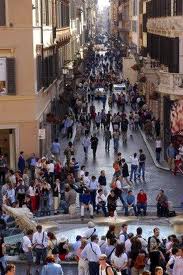
Further down, too, is the fairly nondescript site of the smallest 'country' in the world - you may have thought that the Vatican could claim that title, but at number 68 stands the headquarters of the Sovereign Military Order of the Knights of Malta, which has the privilege of extraterritoriality (they have a better-known palace on the Aventine Hill).
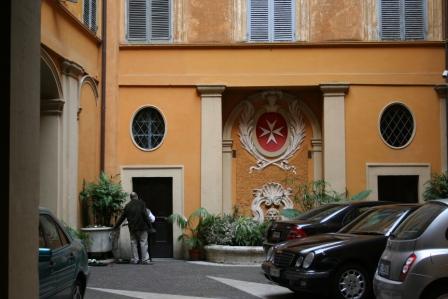
Their red-and-white Maltese Cross flag stands out proudly amongst the usual skyline sea of red, white and green.
The bus has a stop at the north-west corner of the Piazza, convenient for the Spagna Metro station. Leading off at right-angles from here is Via della Croce, just one of the many criss-crossing streets around here full of lovely bakeries, delicatessens and cafés. In this particular road are several excellent restaurants: try the Enoteca Antica - a swish wine-bar now, but recommended too by an old neighbour of mine, a now sadly deceased (having reached his century!) ex-RAF pilot who had it as his 'base' during the war; another I always come back to is 'Otello alla Concordia' , set back from the street on the right in its own attractive courtyard (the current entrance is actually aroud the corner in Via Mario de' Fiori). It serves unpretentious but good tasty food, and is well patronised by locals - always a good sign. Then there is 'Il Re degli Amici': an interesting place where, if you so choose, you can sit at a communal table at the back and share food & conversation with whoever else happens to be there - will you be the 'King of the Friends'? On the walls they display a great variety of original art, much of it by local craftsmen and artists who live in the nearby Via Margutta.
Although this district is a hot-spot for tourists, it's still hard to find a complete 'dud' - Italian chefs are too proud for that!
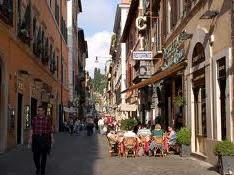
The stop you want, however is the next one (you can always return to Via della Croce later!) Halfway down Via del Babuino, the narrow street (one of the 3 which gives this region the name 'Tridente') you will reach our final talking statue, which also gives its name to the road.
BABUINO
'Il Babuino', 'Baboon' - not a monkey, but the slang-Italian for "dolt" or "fool", has his patch here. A couple of streets further down on the left is Via dei Greci, next to the church of S Atanasio. There on the wall between them, behind a flower-stall, reclines the good old Baboon himself.
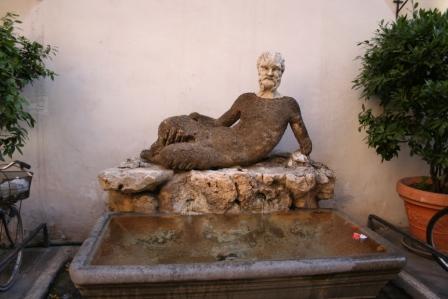
This extraordinary mouldering figure with a completely mismatched head was originally a statue of the wine-god Bacchus's drunken friend Silenus (think Disney's Fantasia - the storm episode to the music of Beethoven's Pastoral Symphony.) Having spent time in various other parts of the city, he was finally set up here (with his new head) behind an old horse-trough basin sometime in the early 1500s. With water still from the Aqua Vergine, you could also fill up a bottle here, however green and leprous he appears (that's probably not a recommendation…). He has been the last survivor (apart from Pasquino) still talking: pages of forthright complaints are occasionally still pasted up beside him, as well as more modern methods of posting comments (e.g. spray-paint!); once again though recent years have seen him being kept clean.
One particularly good quip attributed to him (although some award it to Marforio) was on the occasion of the French occupation of Rome under Napoleon. Pasquino is supposed to have asked, as the army of looters headed homewards through the Porta Flaminia, "Are all Frenchmen thieves like this?"
Babuino replied: "Not all perhaps, but a good part of them are!" - 'Buona-Parte'! - one of the most brilliant plays-on-words of all the Pasquinades.
And with that last shining example of the genre, we have reached the end of our journey. It is only a couple of minutes walk back to the Spagna Metro station, or you could continue up to Piazza del Popolo, where you can catch the 119 back to Piazza Venezia.
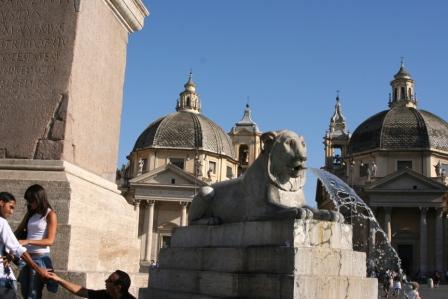
I haven't been very successful in just limiting these comments to the statues themselves- but I hope that the other digressions have been interesting, at least enough to give you some ideas about things to go back and explore in more detail…!
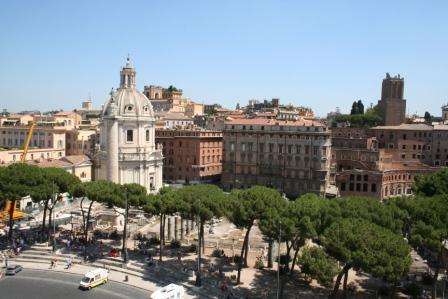
Back to top
